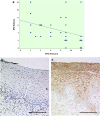The role of EP-2 receptor expression in cervical intraepithelial neoplasia
- PMID: 32851536
- PMCID: PMC7723936
- DOI: 10.1007/s00418-020-01909-2
The role of EP-2 receptor expression in cervical intraepithelial neoplasia
Abstract
Prostaglandin induced signalling is involved in different cancers. As previously described, the EP3 receptor expression decreases with increasing stage of cervical intraepithelial lesions (CIN). In addition, in cervical cancer EP3 is an independent prognosticator for overall survival and correlates with FIGO stages. Currently the role of Prostaglandin 2 receptor 2 (EP2) in CIN is unknown. The aim of this study was to analyse the expression of EP2 for potential prognostic value for patients with cervical dysplasia. EP2 expression was analysed by immunohistochemistry in 33 patient samples (CIN1-3) using the immune-reactivity scoring system (IRS). Expression levels were correlated with clinical outcome to analyse prognostic relevance in patients with CIN2. Data analysis was performed using non parametric Kruskal-Wallis and Spearman rank sum test. Cytoplasmic expression levels of EP2 correlated significantly (p < 0.001) with different grades of cervical dysplasia. Median EP2-IRS in CIN1 was 2 (n = 8), 3 in CIN2 (n = 9) and 6 in CIN3 (n = 16). Comparing regressive (n = 3, median IRS = 2) to progressive (n = 6, median IRS = 4) CIN2 cases the median IRS differed significantly (p = 0.017). Staining intensity (p = 0.009) and IRS (p = 0.005) of EP2 and EP3 correlate inversely. EP2 expression level significantly increases with higher grade of CIN and could qualify as a potential prognostic marker for the regressive or progressive course in CIN2 lesions. These findings emphasize the significant role of PGE2 signalling in CIN and could help to identify targets for future therapies.
Keywords: CIN; Cervical cancer HPV; Cervical intraepithelial neoplasia; EP-receptor; EP2; Prostaglandin E2.
Conflict of interest statement
AH has received research Grants from the “Walter Schulz Stiftung” and a speaker and advisory board honorarium from Roche, Germany. TMK is employed at Roche at the time of manuscript submission.
Figures




